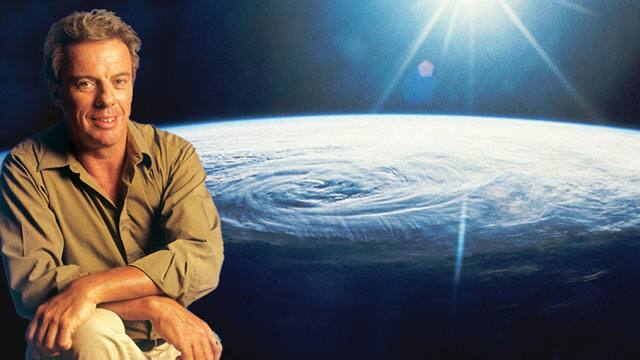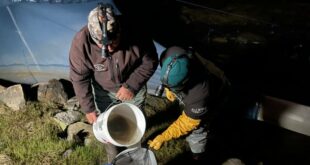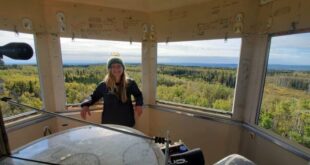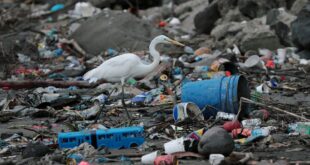Room-temperature superconductors could change the world, but some physicists aren’t convinced they’re possible.

Limitless clean energy, portable MRIs, more efficient quantum computing — these are just a few of the breakthroughs that could be made possible by the discovery of a superconductor that works at room temperature.
“If you made a room-temperature superconductor tomorrow … you’d be famous, you’d win the Nobel Prize,” said Damian Pope, senior manager of scientific research at the Perimeter Institute for Theoretical Physics in Waterloo, Ont.
So it is no wonder that social media is abuzz with news of LK-99, a material that purportedly acts as a superconductor at ambient pressure and temperatures as high as 127 C. A photo of the material levitating over a magnet caught many people’s attention, though experts have said this is no guarantee of superconductivity.
Meanwhile, researchers around the world, as well as some (ill-advised) amateur home scientists, are racing to replicate the results. So far, none have produced LK-99 and observed superconductivity.
This is only the most recent in a long line of claims about this “holy grail” of materials science, as Pope described it — which might explain why experts are approaching LK-99 with sentiments ranging from skepticism to cautious optimism.
“The public should be excited, but I think a certain amount of questioning is called for,” said Alannah Hallas, a principal investigator at the Stewart Blusson Quantum Matter Institute at the University of British Columbia in Vancouver.
What is the claim?
At the end of July, a team of researchers at the Quantum Energy Research Centre, a startup in Seoul, published two papers that have not undergone peer review on arXiv (pronounced “archive”), a pre-print server where scientists frequently report preliminary results.
The papers described LK-99, a new copper-substituted lead apatite — a compound consisting of copper, lead, phosphorous and oxygen. It is named after two of the researchers who discovered it and the year they say they first synthesized it.

What is particularly exciting about this claim is the relative ease of synthesizing the material, Hallas told CBC News in an interview. According to the published methods, LK-99 was created through solid-state synthesis. She compared the process to baking, but simpler, “because there’s no wet ingredients.”
“You just mix together your powder reagents, and you use a mortar and pestle typically to homogenize them to get everything mixed up very well,” said Hallas, who is also an assistant professor in UBC’s physics and astronomy department. “Then you put it in the oven.”
Experts also emphasized that the researchers haven’t done anything incorrectly. It’s common practice to upload preliminary findings to a pre-print server, especially when it’s potentially a major breakthrough.
“If I believed that I had a room-temperature superconductor sitting in my lab … I also would probably post it on [arXiv] as fast as humanly possible,” Hallas said. “That is such a monumental discovery that could change the world … and then the scientific process will work as the scientific process does.”
What is a superconductor?
A material must have two key properties to be considered a superconductor. Below some critical temperature, it must expel all magnetic fields, through what’s known as the Meissner effect, and conduct electricity with zero resistance — meaning absolutely no energy is lost.
Hallas explained that at the atomic level, superconductors work because electrons pair up and stop behaving like electrons.
“Think of it as people dancing in a bar or in a nightclub,” she said. “In a normal metal, everyone is dancing by themselves and … doing their own thing. And maybe they’re, like, bumping into each other and hitting elbows.
“A superconductor is like a scene in a movie where a flash mob comes out and everyone knows all the dance moves and they’re dancing perfectly in sync. And so no one is bumping into anyone [and no energy is lost].”
So far, scientists have only been able to develop materials that keep those properties at extremely low temperatures or extremely high pressures, limiting their application and making them expensive to implement.
Superconductivity was first discovered over a century ago by Dutch physicist Heike Kamerlingh Onnes. He found that solid mercury becomes a superconductor at about –269 C — just four degrees above absolute zero. In the following decades, more superconducting materials were discovered with similar critical temperatures.
The next major breakthrough didn’t come until the 1980s, with the discovery of cuprate compounds — a class of copper-containing materials that can act as superconductors at much higher temperatures, up to about –140 C.
Physicists hope that the next jump will be to a material that can function as a superconductor at room temperature.
Why does this matter?
The applications of a room-temperature superconductor could be revolutionary, experts say.
“One that’s really exciting for Canadians is applications in MRI machines,” Hallas said. “MRIs use superconducting magnets to produce a strong magnetic field, which is the basis of the imaging.”
Current MRI machines use niobium-titanium to generate that field, but it needs to be held at temperatures within 10 degrees of absolute zero. “I’m from Winnipeg, and that’s significantly colder than even Winnipeg will get on the coldest day,” she said.

Using a room-temperature superconductor would remove the need for liquid helium to keep the magnets cool, potentially paving the way for portable MRI machines that could be brought into remote communities.
Subir Sachdev, a professor of physics at Harvard University in Cambridge, Mass., is most excited about another potential application: fusion power, which promises limitless clean energy by imitating what happens in the core of stars like the sun.
“To achieve fusion, you have to take this plasma of charged particles — protons and neutrons and so on — and compress them in a small volume,” he said in an interview with CBC News. “Magnetic fields are what you’d use to do that.”
Sachdev said it has already been proposed that existing superconductors could make fusion a reality, but having room-temperature superconductors would make it that much easier.

For Pope of the Perimeter Institute, it’s also important not to overlook what this could mean for our infrastructure. “Those big overhead transmission lines that you see, about 15 per cent of the power is lost from the power generating station till it gets to your home. [If we] replaced all of those wires there with superconducting wires, the amount lost would be zero.”
For the same reason, computers could become hundreds of times faster and more energy-efficient, with no more energy lost as heat.
Why are physicists skeptical?
This is not the first unidentified superconducting object (USO) to appear on arXiv.
“Every few years there’s some claim of a new material that suddenly is a better superconductor,” Sachdev said. “The last time that really turned out to be true was in 1987,” with the discovery of cuprate compounds.
Pope had a similar sentiment, adding that “it’s kind of a quantum leap” to go from materials that superconduct at –140 C to over 100 C.

Discovery of room temperature superconductors a ‘holy grail of physics’
When it comes to the photo that captured attention on social media, Hallas said it’s important to remember that “there are other physical explanations that can lead to magnetic levitation.”
“If you go on Amazon, you can purchase for under $100 a levitating flower pot, and that has nothing to do with superconductivity. That’s actually just magnetic repulsion.”
Hallas also noted that the papers didn’t contain everything you would typically see in a peer-reviewed journal, and some of the reported structure gave her pause.
“The actual characterization of the final material is really incomplete…. It doesn’t really pass the sniff test in terms of the sort of intuition of how that chemical reaction would unfold. It kind of involves some sort of unphysical configurations.”
What if LK-99 is the real deal?
Let’s say, in the next few weeks, labs around the world are able to replicate the published methods, reproduce the results and provide independent confirmation that LK-99 is, indeed, a superconductor. Does that mean that all of these innovations are right around the corner? Not quite.
Hallas said although the straightforward method to synthesize LK-99 means production seems very achievable on an industrial scale, “that’s only the first step in a material actually kind of coming to fruition in terms of a usable technology.” Other considerations include safety, cost, ability to withstand different environmental conditions and ease of fabrication into different configurations like wires.
Still, regardless of what happens with LK-99, researchers are happy to have some attention placed on materials science.
“I’ve never experienced anything like this in my research field, to see the general public become so excited about a reported discovery,” Hallas said. “It’s giving a real snapshot of what our day-to-day process looks like and and what goes into the type of science that we’re doing.”
ABOUT THE AUTHOR
Science communicator
Darius Mahdavi is a CBC science specialist based in Vancouver. He covers the latest in the world of science, with a focus on the impacts of climate change on the people and ecosystems of Canada. He’s worked as a researcher and graduated from the University of Toronto, where he earned a degree in conservation biology and immunology. If you have a science or climate question, reach out at darius.mahdavi@cbc.ca.
*****
Credit belongs to : www.cbc.ca
 Atin Ito First Filipino Community Newspaper in Ontario
Atin Ito First Filipino Community Newspaper in Ontario






